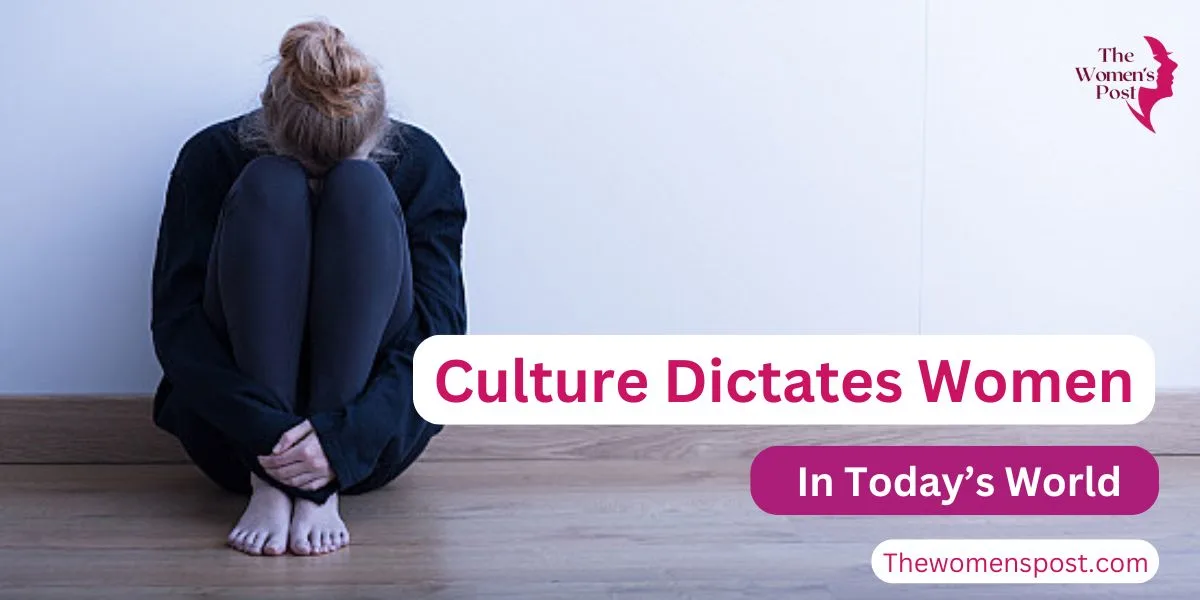A Guide to Hormonal Changes: Understanding the Phases of the Menstrual Cycle
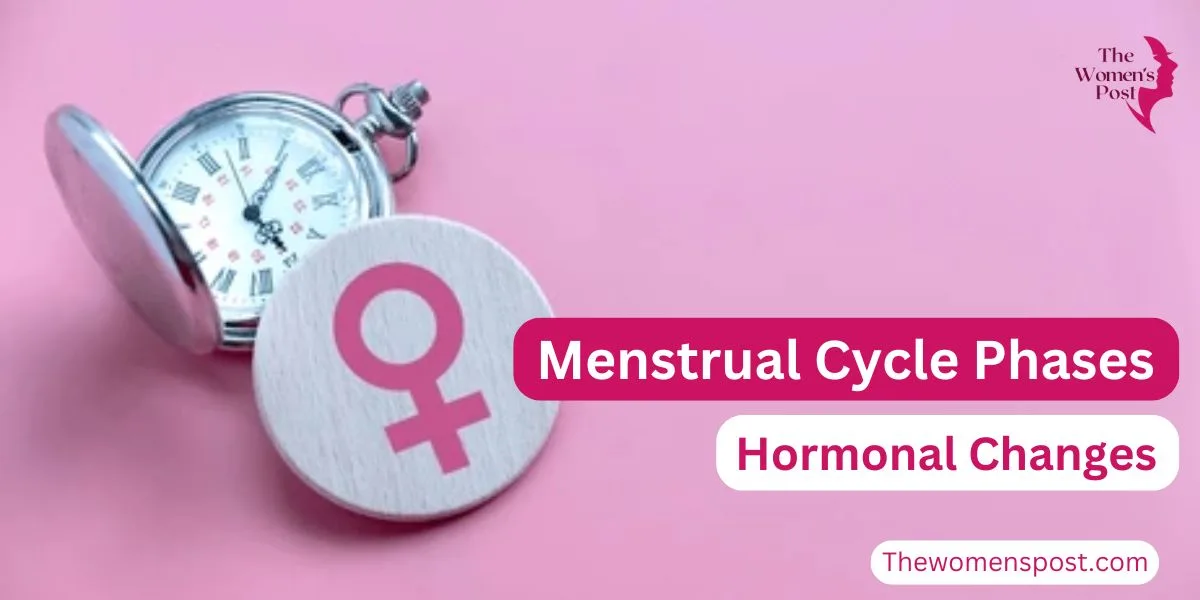
Key Points
- The menstrual cycle is a normal part of a woman’s life that lasts 21 to 35 days and gets her body ready for a possible pregnancy.
- There are four main menstrual phases: menstrual, follicular, ovulation, and luteal. Hormonal changes cause each of these phases.
- Hormones like estrogen and progesterone can change a woman’s mood, energy, and physical symptoms.
- The cycle begins at puberty (ages 9–15) and persists until menopause (ages 40s–50s).
- Cultural attitudes and education about menstruation differ globally, impacting women’s understanding menstrual cycle phases and hormonal changes.
What is the Menstrual Cycle?
The menstrual cycle happens every month in a woman’s body to get it ready for a possible pregnancy. It changes hormones that have an effect on the ovaries and uterus. The average cycle lasts about 28 days, but it can last anywhere from 21 to 35 days. Each woman’s experience is different. Women can take better care of their health and know when something might need medical attention if they know about the different phases of their menstrual cycle and how their hormones change.
The Different Parts of the Menstrual Cycle
The menstrual cycle has four menstrual phases: the menstrual phase, the follicular phase, the ovulation phase, and the luteal phase. Hormones like estrogen, progesterone, follicle-stimulating hormone (FSH), and luteinizing hormone (LH) cause the body to change in different ways during each phase. Let’s look at each phase of the menstrual cycle in order to fully understand what happens during menstrual cycle phases.
Age and the Cycle of Menstruation
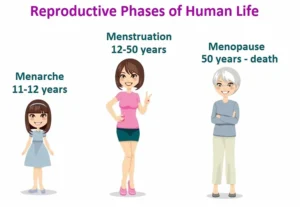
Also Read: Food Sustainability Leader Changing Food Systems: Iseult Ward
The menstrual cycle usually starts in puberty, with the first period (menarche) happening between the ages of 9 and 15. Cycles that start early may not be regular, but they usually become more stable in the late teens or 20s. The cycle goes on until menopause, which usually happens in the 40s or 50s, when hormone levels drop and periods stop. As menopause gets closer, cycles may become irregular again, which will change the menstrual phases.
Cultural and Educational Context
Menstruation is a common experience, but different cultures see it in different ways. In some places, it’s okay to talk openly about menstrual phases, but in others, shame may make it harder to understand the phases of the menstrual cycle and how hormones change. Women who learn about the menstrual cycle can keep track of their cycles, deal with symptoms, and get help if their cycles aren’t normal. Schools, doctors, and websites are all important places to get this information.
A Comprehensive Guide to Phases of the Menstrual Cycle and Hormonal Fluctuations
Introduction
Every month, women’s bodies go through a natural process called the menstrual cycle that gets them ready for pregnancy. Hormones, which are chemical signals that control changes in the ovaries and uterus, cause it. Women can better understand their bodies, deal with symptoms, and make smart health choices if they know about the different phases of their menstrual cycle and how hormones change. This guide talks about the four menstrual phases, the hormones that are involved, how changes in hormones affect the menstrual cycle, and answers common questions.
Who Goes Through the Menstrual Cycle?
The menstrual cycle begins at puberty, which is usually between the ages of 9 and 15, and ends at menopause, which is usually in the 40s or 50s. A 16-year-old high school student in New York, a 30-year-old teacher in India, or a 45-year-old nurse in Brazil all go through the cycle. However, their cultural and educational backgrounds may affect how they understand and deal with it. Women need to learn about their menstrual phases in order to feel confident about them. This can be done through school programs, family talks, or online resources.
The Four Stages of the Menstrual Cycle
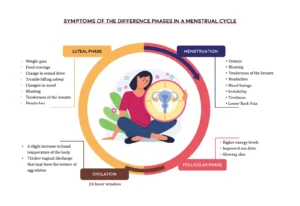
Also Read: The Hidden Victims of Climate Change: Women in Vulnerable Communities
There are four menstrual phases, and each one has its own physical and hormonal changes. Here’s a more in-depth look at what happens during each phase of the menstrual cycle, along with a table that sums up the most important points.
|
Phase |
Length of Time for Each Phase | Key Events | Changes in Hormones |
| Menstrual Phase | 3–7 Days | The lining of the uterus comes off, which causes menstrual bleeding. |
The levels of estrogen and progesterone go down, which causes the lining to break down. |
|
Follicular Phase |
Days 1–14 (10–22 days) | Follicles grow in the ovaries, and the lining of the uterus gets thicker. | FSH makes follicles grow, and estrogen makes the lining of the uterus thicker. |
| Ovulation | About the 14th day | The mature egg leaves the ovary and moves to the fallopian tube. |
The LH surge causes the egg to be released, and the estrogen level rises and then falls. |
|
Luteal Phase |
Days 15–28 (9–16 days) | The corpus luteum forms and gets the uterus ready for pregnancy. If there is no pregnancy, the lining sheds. |
If there is no pregnancy, progesterone levels go up, estrogen levels go up a little, and both levels go down. |
1. The Menstrual Phase (Days 1–5)
The menstrual phase starts on the first day of your period, when the uterus sheds its lining (endometrium). This is one of the most important menstrual phases. This lining, which was built up in the last cycle to support a possible pregnancy, leaves the body as menstrual blood, which is made up of blood, mucus, and tissue. The phase usually lasts between 3 and 7 days, but this can vary from woman to woman.
- Changes in Hormones: The levels of estrogen and progesterone are at their lowest, which makes the lining of the uterus break down and fall off. This is an important part of the menstrual cycle hormones explained.
- Effects on the Body and Mind: Low hormone levels can cause women to have cramps, bloating, tiredness, or mood swings. Some people may also have sore breasts or lower back pain, which shows how changes in hormones affect the menstrual cycle.
2. The Follicular Phase (Days 1–14)
The follicular phase is another important menstrual phase. It starts on the first day of the period and goes on until ovulation. The pituitary gland releases follicle-stimulating hormone (FSH) during this phase. This tells the ovaries to make follicles, which are small sacs that hold eggs. Most of the time, one follicle becomes dominant and gets an egg ready to be released. The follicles produce more estrogen, which thickens the uterine lining for a potential pregnancy.
- Changes in Hormones: FSH makes follicles grow, and estrogen levels rise steadily, reaching their highest point just before ovulation. This is an important part of the menstrual cycle hormones explained.
- Effects on the Body and Mind: Many women feel more energetic and in a better mood during this time because their estrogen levels are rising. This shows how hormonal changes affect the menstrual cycle. Your skin may look clearer, and your hair may feel healthier.
3. Ovulation (Around Day 14)
Ovulation is an important menstrual phase. It happens when the mature egg leaves the dominant follicle in the ovary. This usually happens around day 14 of a 28-day cycle, but it can happen at different times. The egg moves down the fallopian tube, where sperm can fertilize it. This is the most fertile time in the cycle, which lasts for about 24 hours.
- Changes in Hormones: A rise in luteinizing hormone (LH) causes the egg to be released. Estrogen levels rise just before this surge and drop after it. This is an important part of how menstrual cycle hormones work.
- Physical and Emotional Effects: Some women notice things like stretchy cervical mucus, a small rise in body temperature, or a higher sex drive. Mild pelvic pain (mittelschmerz) may also occur, which shows how changes in hormones affect the menstrual cycle.
Also Read: Balancing Motherhood and Career: The Need for Better Maternity Leave and Flexible Work Policies
4. The Luteal Phase (Days 15–28)
The corpus luteum forms from the broken follicle after ovulation. This is the luteal phase, which is one of the last menstrual phases. This structure makes progesterone and some estrogen, which gets the lining of the uterus ready for a fertilized egg to implant. The corpus luteum breaks down, hormone levels drop, and the cycle starts over with the next period if pregnancy doesn’t happen.
- Changes in Hormones: Progesterone levels go up to keep the lining of the uterus healthy, and estrogen levels go up a little bit. If a woman doesn’t get pregnant, both hormones go down, which starts her period. This is explained in the section on menstrual cycle hormones.
- Physical and Emotional Effects: This phase is often linked to premenstrual syndrome (PMS), which can cause mood swings, bloating, breast tenderness, and tiredness. Some women may feel cravings or get angry, which shows how changes in hormones affect the menstrual cycle.
How Changes in Hormones Affect the Body
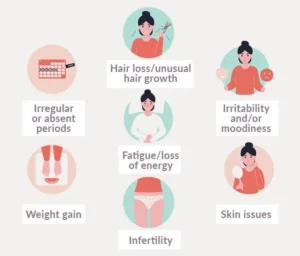
Hormonal changes have effects on the menstrual cycle that go beyond the reproductive system. This is how they affect different parts of health:
- Mood and Energy: Rising estrogen levels during the follicular phase can make you feel better and give you more energy. On the other hand, rising progesterone levels during the luteal phase can make you feel tired or moody.
- Skin and Hair: Estrogen makes skin clearer and hair healthier, but hormonal changes before your period can cause acne or oily skin.
- Digestion: Progesterone can slow down digestion, which can cause bloating or constipation, especially during the luteal phase.
- Libido: Estrogen and small amounts of testosterone are at their highest levels around ovulation, which can make you want to have sex more.
- Sleep: Changes in hormones, especially during the luteal phase, can make it hard to sleep, which can lead to insomnia or poor sleep quality.
The Menstrual Cycle and Age
The menstrual cycle changes as a woman gets older, with the different phases of her menstrual cycle changing as well:
- Puberty (Ages 9–15): The beginning of the menstrual cycle is the first period, or menarche, which happens between the ages of 9 and 15. It can take up to three years for the body to get used to early cycles, which are often irregular.
- Reproductive Years (Late Teens to 40s): Cycles usually get more regular and last between 21 and 35 days. Stress, diet, and health problems can all cause changes in the different phases of the menstrual cycle.
- Menopause (40s–50s): Periods become irregular and then stop as hormone production slows down. This time of change, called perimenopause, can last for a few years and change how your menstrual cycle works.
Also Read: Feeling Tired All the Time? Your Thyroid Might Be the Culprit – Especially for Women!
Cultural and Educational Setting
Menstruation is a universal experience for women; however, cultural perceptions differ. Some communities talk openly about menstrual phases and give women access to education and resources. In some cases, stigma or not having enough information can make it harder for women to understand their cycles. For instance, a young woman who lives in the country might depend on what her family knows, while a college student who lives in the city might use apps like Clue to keep track of her cycle. Women can learn how to manage their symptoms, spot problems, and feel empowered through schools, healthcare providers, and websites.
Conclusion
Knowing about the different phases of the menstrual cycle and how hormones change can help women take charge of their health. Women can better handle their physical and emotional symptoms by knowing the different phases of their menstrual cycle: menstrual, follicular, ovulation, and luteal. Whether you’re a teenager going through your first periods or an adult getting close to menopause, knowing what happens during the different phases of your menstrual cycle can help you a lot. If you’re worried about your cycle, talk to a doctor for personalized advice.
Five Commonly Asked Questions (FAQs)
1. How long does a normal menstrual cycle last?
The average cycle lasts 28 days, but it can last anywhere from 21 to 35 days. Changes are normal, especially during puberty or perimenopause, and they can change what happens during different phases of the menstrual cycle.
2. What are the most important hormones that control the menstrual cycle?
Estrogen, progesterone, follicle-stimulating hormone (FSH), and luteinizing hormone (LH) control the cycle by regulating ovulation and changes in the uterus, as explained in menstrual cycle hormones.
3. What does the menstrual cycle do to my mood and energy levels, and what can I do about it?
Changes in hormones, especially drops in progesterone during the luteal phase, can make you feel tired or moody. Regular exercise, a balanced diet, and stress management may help, which shows how hormonal changes affect the menstrual cycle.
4. What are some common problems with the menstrual cycle?
Irregularities can mean not having your period, bleeding heavily or lightly, or having a lot of pain. Stress, hormonal imbalances, or conditions like polycystic ovary syndrome (PCOS) can cause these changes in the menstrual phases.
5. How can I keep track of my period?
You can keep track of your period by writing down the first day of it, using a calendar, or using a smartphone app. This helps you guess when your period will start, when you will ovulate, and when your menstrual cycle is off.



